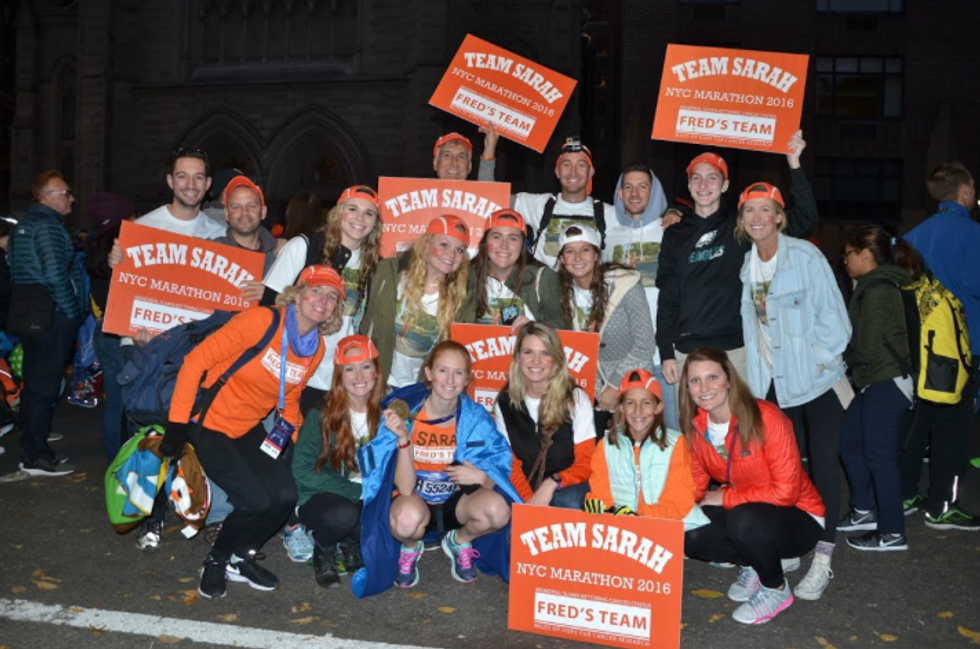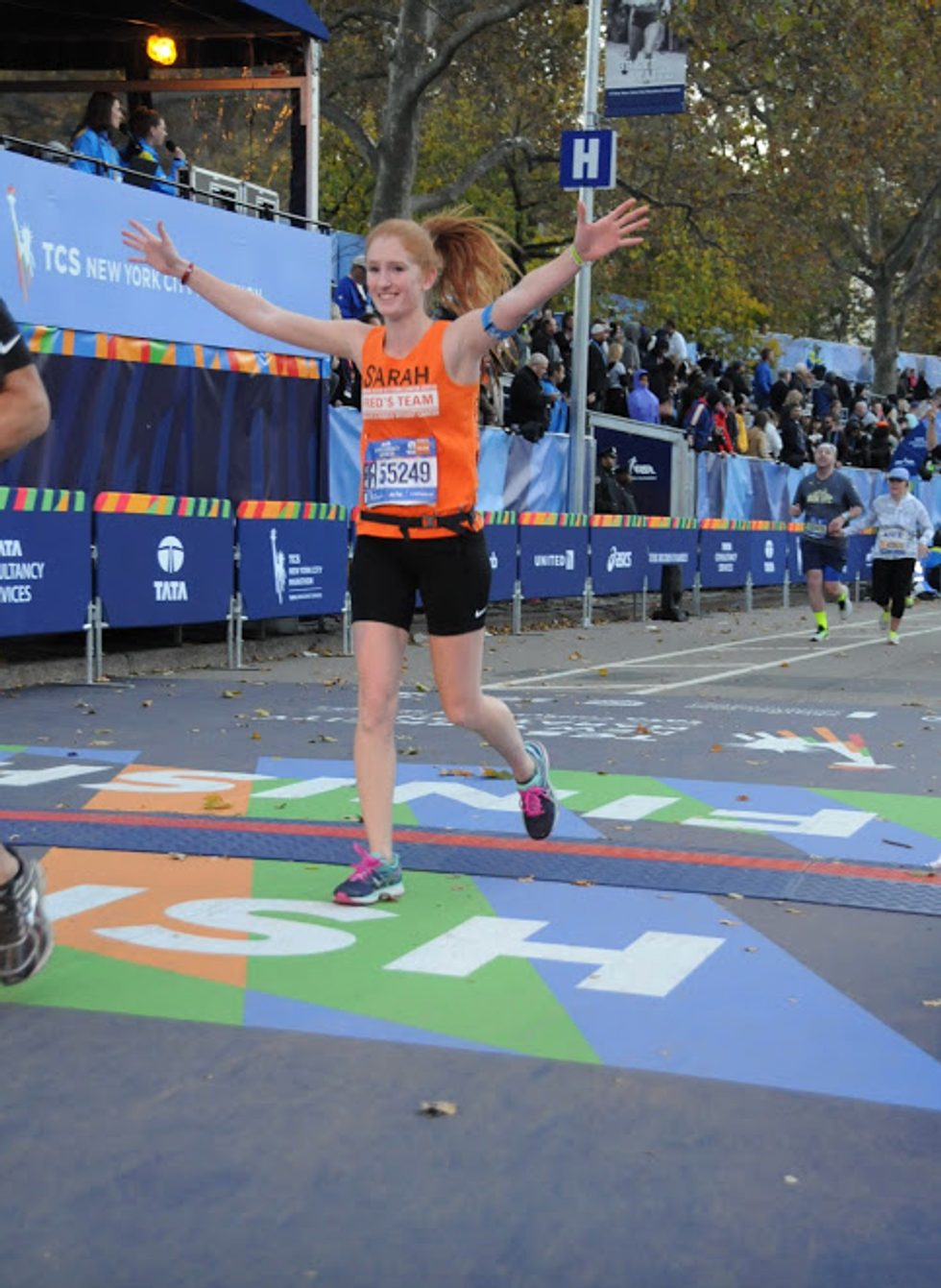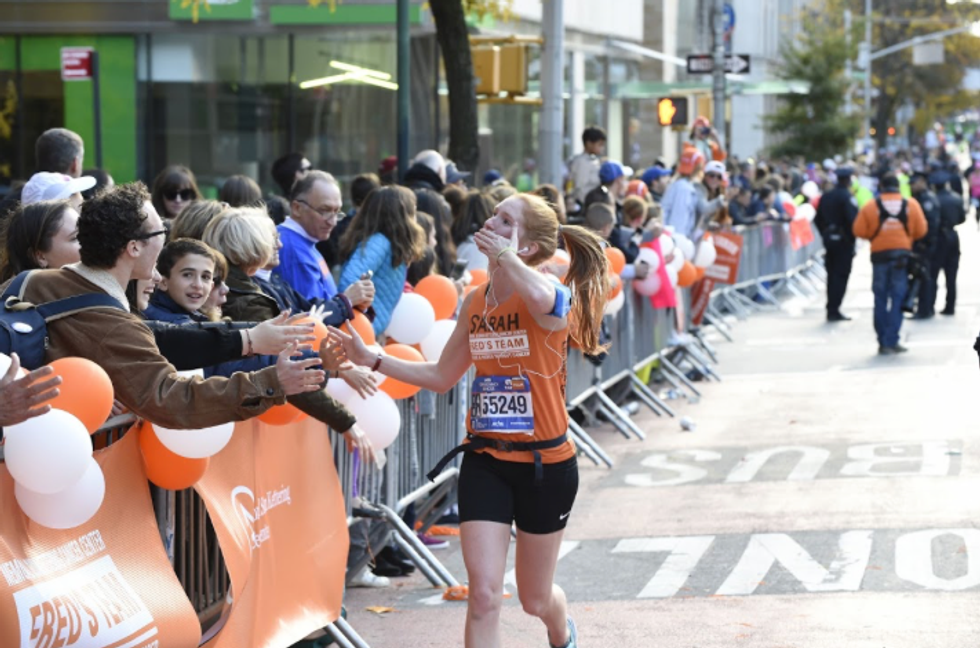Five boroughs, 26.2 miles, crowds of cheering bodies. Adrenaline comes in peaks and troughs. Limbs labor through animated city streets. For 23-year-old Sarah DeVita, the New York City marathon on November 6 wasn’t just a race — it was personal.
Four years ago, Sarah was diagnosed with Chronic Myeloid Leukemia (CML). Doctors found the cancer after she’d noticed strange bruising and went for a blood test. Her bone marrow was producing underdeveloped white blood cells at a massive rate — 30 times the normal amount.
Sarah says that CML is different from the kind of Leukemia people normally think about. Chronic Leukemia is slow-acting, and she didn’t need intense IV chemotherapy — that’s only for acute types which are more aggressive. Soon after doctors diagnosed her, Sarah was admitted to Memorial Sloan Kettering Cancer Center where she stayed for six days of treatment.
So began her journey to give back to those who’d devoted so much to ensure her recovery. And on November 6, Sarah ran for Fred’s Team, an athletic fundraising program that allows you to donate to the cancer research area of your choosing. Sarah chose the Leukemia division and raised over $14,000. The final number came to $14,722.40.
During her time at Memorial Sloan Kettering, Sarah had seen fliers advertising for Fred’s Team. But it wasn’t until last year when she ran a half marathon in Richmond and raised $6,000 through the organization, that she set her sights on the New York City marathon. “I knew their main event was the marathon, so I thought why not go for the full — it’s their biggest one,” she says.
A 2015 University of Virginia graduate, Sarah was a sprinter and jumper on the track team so says the transition was something she had to ease into. “I signed up in February or March and didn’t get into training until around April or May,” Sarah says. “I ran a lot of short distances, and by summer I was doing 10+ mile runs.”
By the fall, Sarah lengthened those runs to 15, getting all the way up to 20 miles three weeks before the marathon. “Don’t get bogged down by all the training,” she says. “But if you do put in the training, it makes the marathon even more fun.”
The day of, Sarah had the support of her family and friends, all clad in orange Fred’s Team gear. And from the start village until the finish line, she heard strangers cheering her name — she had it printed on the front of her shirt.
At mile 8, Sarah was joined by her boyfriend Christian who ran with her past the mile 16 mark at the end of the Queensboro Bridge. With no spectators, it was almost jolting how quiet it was — so much different than running through the clamor of cheers.
“Right when you come off that bridge, there are these huge crowds, and everyone is suddenly so loud,” she says. “My brother and his friends were there — seeing them and tens of thousands of people was a whirlwind.”
Sarah’s dad met her at mile 20 and ran with her until mile 24. “Those were probably the toughest part,” she says. “The whole time, I was struggling on the inside, but you look around and can’t help being excited by the cheering and crowds, so you keep going.”
Sarah’s sister, Mimi, a senior Nursing student at Villanova, was also in the crowd with the rest of their family. And she was there four years prior when Sarah got treatment at Memorial Sloan Kettering.
“Being with Sarah in the hospital was almost an out-of-body experience,” Mimi says. “She didn't look sick, she didn't feel sick — she was acting the way she's acted my whole life.”
Mimi says it was scary, but the reassurance from doctors and nurses eased her family's nerves. And her stay with Sarah actually inspired her to study nursing.
“The moment I knew I wanted to be a nurse was that night I stayed at the hospital,” Mimi says. “I always knew I wanted to help people in a very direct way but never knew how. Watching the nurses care for her, make her and my family feel comfortable, really inspired me."
Sarah’s in remission. Ever since she was released four years ago, she’s had to take an oral chemotherapy drug — a pill twice a day every day. The medicine, she explains, stops the overproduction of white blood cells in her body. Without it, the cancer would potentially resurface.
“20 years ago, for the disease that I have, the only option would have been a bone marrow transplant,” Sarah says. “Now, there are three drugs that treat my disease, and that’s all because of research funded by donation.”
“Everyone can name a person they know who has cancer,” she continues. “Donating to these causes for research works — it really works. And my fundraising efforts have been successful because I’m able to tell my story.”
Her story started with a diagnosis. It peaked when Sarah crossed the finish line in Central Park that fall afternoon. And the story goes on.
“To see her finish and get her metal was amazing,” Mimi says. “Although you knew she wanted to collapse, she stayed standing. People pride themselves on running the New York City marathon, and to be able to say you've ran it with cancer — that's mind blowing.”
Mile 17 was the magic number. It marked the best part of the marathon for Sarah — right at mile 17, on 68th street, was one of the Memorial Sloan Kettering buildings. And the promise of that one moment — passing the place responsible for her recovery — kept her going.
“Every time I got tired during my runs, I’d want to quit,” she says. “But then I’d think about running past, and it would give me an adrenaline rush.”
After Sarah ran by the hospital, a Fred’s Team cheering section right outside — her family among the crowd — she had to stop and catch her breath. “It was a pretty emotional moment for me,” she says. “Four years ago I was in that same hospital looking down from a room, so being able to run by during the marathon was amazing.”
The back of Sarah’s shirt read, “Survivor. Imagine a world without cancer.” And passing Memorial Sloan Kettering, she blew the hospital a kiss. Four years later.






















